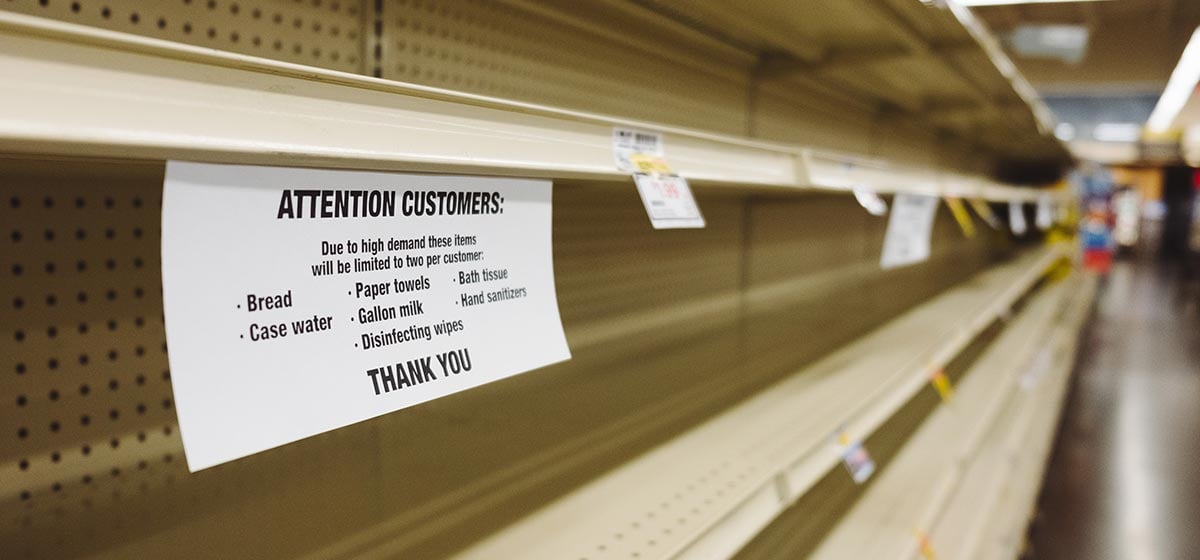Join 40,000+ sales and marketing pros who receive our weekly newsletter.
Get the most relevant, actionable digital sales and marketing insights you need to make smarter decisions faster... all in under five minutes.
Out of stock: Consumers are ready to spend, but the supply isn't there

Jun 19, 2020

Back in April, after a month of quarantine, I was clinging to signs of warmer weather on the horizon. I was dreaming of all the socially distant activities one can do outside and I had a brilliant idea.
“I’ll get a bike!”
I thought a beach cruiser would be the perfect fit for getting some fresh air in my shoreline town in Connecticut. I could just picture the smell of the salt air, the blue skies, the sun, the wind in my hair, and I knew this was a purchase I was ready to make!
It took one Google search to find many options for local shops that had just the bike I was looking for. I eagerly clicked into the first store, found the perfect bike, and then I saw it.
The dreaded words: Currently out of stock.
Site after site that’s all I got. No one, from big chains to small retailers, had any bikes that I was looking for. I signed up to get notified when they were back in stock and still, two months later, I have yet to hear anything.
What I’ve since learned is that this trend is hardly confined to just bicycles. The coronavirus pandemic has hit the supply chain hard for businesses across the board.
According to INC, while consumers might be ready to buy, many are being met those same four words: Currently out of stock.
After months of lockdown, how can businesses be short on product?
The COVID-19 pandemic and subsequent stay-at-home orders thrust us all into a new reality. The activities we once took part in and often took for granted were suddenly impossible. Thus, consumers had to find ways to turn their homes not just into living spaces, but into schools, offices, gyms and more.
In addition to the run on toilet paper and bicycles, other businesses saw a massive increase in demand as we all adapted to making life in quarantine comfortable. Here’s just a few things you may have noticed going quickly out of stock:
- At-home fitness equipment
- Toys and games (jig-saw puzzles, anyone?)
- Inflatable pools and pool toys
- Patio furniture and grills
- Yeast (yes, yeast)
- Hair dye
- Home electronics
- Hand sanitizer
- Cleaning supplies
The reality is that this level of demand wasn’t anticipated by retailers of these products. On top of that, any businesses that rely on manufacturing from hard-hit regions have been hindered significantly in being able to keep up with this sudden influx in interest.
High demand is a good thing, right?
Under normal circumstances, generating so much demand for a product that you’re nearly selling out would be a dream! During a global health crisis, not so much.
The problem lies in the uncertainty of the post-COVID world.
If businesses run out of stock now, they are in a precarious position for the foreseeable future.
Look at Yardbird, for example, a direct-to-consumer outdoor patio furniture seller. They saw a 400% year-on-year increase in sales in May alone, and in just 15 days they reported more website traffic than they had seen for all of 2019.
So, why is this a problem?
Like many businesses, Yardbird had ordered enough inventory to last them through their peak season, the end of August. They are now likely to sell-out within a few weeks. Because their inventory is imported from overseas, re-stocking is more difficult due to COVID-19.
Like many businesses, if Yardbird can’t restock they will stop making money when their current inventory runs out. Even if they could easily restock, as states begin re-opening, demand for their product may or may not stay the same.
Businesses like Yardbird have to navigate a careful balancing act.
Run out of inventory and be unable to restock, they lose money.
Restock too much inventory and demand goes down, they lose money.
What can brands do to help keep customers happy with a slowing supply?
All this doesn’t mean that businesses have to stay stuck in limbo while the current crisis plays itself out. There are ways to maintain a relationship with consumers while the supply chain stabilizes.
Find other ways to provide value while customers are waiting for items to arrive or restock.
I don’t know about you, but I know at least 10 people that have ordered a Peloton bike since the quarantine began. Because of the sudden high-demand for their already in-demand product, Peloton customers have had to endure long waits for delivery.
But Peloton didn’t let that stop customers from being able to get value from their brand right away. They offered their fitness app for free for 90 days. The app contains at-home workouts that don’t require their signature equipment.
Not only does the app allow customers who are waiting on their bike to still get a good workout, but it also gives would-be customers a taste of Peloton's service for free while stuck at home.
Make order cancellations easy
Because it’s tough to anticipate inventory needs right now, distributors like Gym Source, who specializes in at-home fitness equipment, are implementing “no questions asked” cancellation policies. This helps alleviate risks for the retailers who order their inventory from Gym Source by offering them the flexibility to place an order based on current demand, and to cancel it if things shift.
The same can be said for direct-to-consumer brands.
How many of us tried to order toilet paper, hand sanitizer, or disinfectant on Amazon back in March? I know people who are still waiting for them. Thankfully, Amazon makes it extremely easy to cancel an order if it has not yet shipped.
It’s better to be flexible with customers, even if it means losing orders in the short term. The long term relationship you’re building through that trust will go a long way later.
Keep your website and marketing up to date!
Back to my beach cruiser saga.
Because I had been searching for a specific bike, I inevitably started getting retargeted from various bike brands and retailers. One such ad, showing me the exact bike I had been looking for, got me!

The ad specifically stated that they had beach cruisers in stock, so naturally, I clicked in excitement.
I was taken to a landing page for the bike that was in the ad and to my delight I saw a big “Buy Now” button, with no warning that it may be out of stock.
Unfortunately, when I went to click the button it was disabled.
I went to other product pages for bikes on their website and noticed that all of their other options showed those same four lovely words: “Currently out of stock.”
Here’s a good lesson for you: Don’t run ads for products you no longer have!
Make sure that your website is clear on what is in stock and what isn’t. If you can, add in predictions for when an item might be available or offer an opt-in to get an alert as soon as it is.
This transparency will go a long way when it comes to building trust with your customers.
I can tell you, I won’t be going back to that bicycle website when they restock.
Things will eventually get back to normal
We don’t know how long this environment will last and it can be frustrating if you’re a consumer who is ready to spend your hard-earned money with a brand, only for them to have nothing left for you to buy.
It’s even harder for those businesses who are quickly running out of inventory and have to live in limbo when it comes to the supply chain stabilizing.
If you’re a consumer looking to buy, stay patient! These brands want and need your business.
If you’re a brand, do what you can to stay in touch with your customers. Even if you don’t have all the answers, some information is better than none.
Free Assessment: